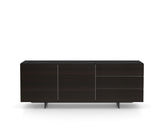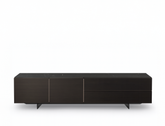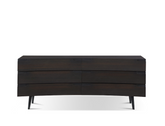Dining Table Benefits You Can't Ignore

A dining table is more than just a piece of furniture; it’s a central element in any home’s design and functionality. In today’s open-concept kitchens, many homeowners consider alternatives like kitchen islands with bar stools. As the trend of removing dividers to create more fluid and multifunctional spaces grows, particularly in smaller homes, the traditional dining table setup is sometimes sacrificed. But the question arises—does the dining table still have a place in modern living spaces?
If you're contemplating whether to keep a dining table or replace it with other options, this article will explore the undeniable benefits of having a dining table in your home.
The Advantages of Having a Dining Table
1. A Dining Table Helps Maintain Work-Life Balance
In today’s fast-paced world, our eating habits often reflect our busy lifestyles. Breakfast might be a quick bite on the way out the door, and lunch might be eaten at the desk during a hectic workday. This blending of work and mealtime can make it difficult to maintain a clear boundary between work and personal life, which is crucial for overall wellness.
Having a dedicated dining space encourages you to step away from your work or study area and take a true break. Eating lunch at the dining table, rather than at your work desk, reinforces the separation between work and relaxation, helping you recharge and avoid burnout.
2. It Encourages Healthier Eating Habits
Along with supporting a better work-life balance, eating at a dining table can lead to healthier eating habits. When you eat in a designated dining area, without the distractions of work or other tasks, you're more likely to enjoy your meal and focus on what you’re eating. This mindfulness can prevent stress eating and reduce the risk of unhealthy weight gain.
Moreover, the ritual of sitting down at a dining table for a meal can encourage you to prepare healthier, more balanced meals, as opposed to the quick snacks or fast food that might be consumed in front of the television or in bed.
3. A Dining Table Defines Open-Concept Spaces
In many modern homes, open-concept designs blur the lines between the kitchen, dining room, and living room. While this creates a spacious and fluid environment, it can also lead to a lack of distinct zones within the home. A dining table can help delineate the dining area from other parts of the open space, creating a clear and dedicated area for meals.
This separation not only enhances the dining experience by reducing distractions but also maintains the integrity of the living or entertainment area, ensuring it remains a place for relaxation and socialization.
4. It Brings People Together
The dining table has long been a symbol of togetherness in the home. It’s where families gather to share meals, celebrate special occasions, and enjoy each other’s company. Whether it's a nightly dinner, a weekend brunch, or a holiday feast, the dining table is often the centerpiece of memorable moments and family traditions.
Sitting around the dining table fosters communication and connection, especially for families with young children. It provides an opportunity to engage in conversations, share stories, and strengthen familial bonds.
5. A Dining Table Provides a Versatile Work and Study Space
In addition to its primary function as a place to eat, a dining table can serve multiple purposes, especially in homes where space is limited. The spacious surface of a dining table makes it an ideal spot for various activities, from working on projects and completing homework to hosting crafts and other creative endeavors.
Unlike a kitchen island, which is often higher and less comfortable for extended periods of sitting, a dining table’s standard height is conducive to a variety of tasks, making it a versatile addition to any home.
Dining Table vs. Kitchen Island: Which Is Better?
When designing a modern dining area, homeowners often find themselves choosing between a dining table and a kitchen island. Both have their distinct advantages and contribute differently to the ambiance and functionality of a space. Here’s a closer look at how they compare in key areas:
1. Food Preparation and Cooking
For those who prioritize a spacious area for meal preparation, a kitchen island often comes out on top. Its proximity to the kitchen’s primary work zones and its durable materials make it ideal for cooking tasks. However, some dining tables are also designed with scratch- and stain-resistant surfaces, making them a viable option for those who prefer a more traditional dining setup.
Ultimately, the choice between a kitchen island and a dining table for food preparation depends on your personal preferences and cooking habits.
2. Dining Experience
When it comes to dining, tables are designed with comfort in mind. Their height and configuration are optimized for use with standard dining chairs, allowing for a relaxed and enjoyable dining experience. This is particularly important during gatherings, where a dining table can easily accommodate additional seating.
In contrast, kitchen islands are typically taller and paired with bar stools. While this setup works well for casual and quick meals, it may not be as comfortable for longer dining sessions, especially if the stools lack backrests.
Conclusion
The dining table remains a vital part of the home, offering a range of benefits that alternatives like kitchen islands may not fully provide. Whether you value the sense of tradition it brings to family meals, the clear definition it gives to open-concept spaces, or its multifunctional use as a work or study area, a dining table is a worthy investment in any home.
If you cherish the experience of sharing good food and stories with loved ones, choosing a dining table that fits your needs and complements your style can enhance these moments. Embrace the timeless value of a dining table and create a space where memories are made and cherished.
FAQs
1. Can a kitchen island replace a dining table?
While a kitchen island can serve as a dining space, it may not offer the same comfort and versatility as a dining table. Kitchen islands are typically higher and paired with bar stools, which may not be ideal for extended meals. Dining tables, with their standard height and ability to accommodate more guests, are often better suited for a traditional dining experience.
2. How does a dining table contribute to healthier eating habits?
Eating at a dining table encourages mindful eating by reducing distractions and allowing you to focus on your meal. This can lead to healthier eating habits, as you are more likely to prepare balanced meals and avoid overeating when you eat in a dedicated dining space.
3. What are the benefits of having a dining table in an open-concept home?
In open-concept homes, a dining table helps define the dining area, creating a clear separation from the kitchen and living room. This enhances the dining experience by reducing distractions and maintaining distinct zones within the space.
4. Can a dining table be used for activities other than eating?
Yes, a dining table is a versatile piece of furniture that can be used for a variety of activities, including working, studying, and crafting. Its spacious surface and comfortable height make it suitable for many different tasks.
5. Is a dining table necessary in a small home?
Even in a small home, a dining table can be a valuable addition. It provides a dedicated space for meals and other activities, helping to maintain a sense of order and functionality in the home. Some dining tables are designed to be compact or extendable, making them ideal for small spaces.
6. How does a dining table enhance family bonding?
The dining table is often a central gathering place in the home, where families come together to share meals and conversations. This regular interaction fosters communication, strengthens relationships, and creates lasting memories.
Conclusion
The dining table is more than just a piece of furniture; it’s a symbol of connection, comfort, and tradition. By choosing the right dining table for your home, you can create a space that not only serves practical purposes but also enriches the lives of those who gather around it. Whether for daily meals, special occasions, or multifunctional use, the dining table remains an essential part of the modern home.
Check out Prestige Affairs premium modern dining tables in Singapore and discover myriads of excellent choices for your dining space.







